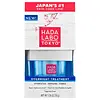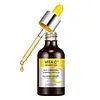What's inside
What's inside
 Key Ingredients
Key Ingredients

 Benefits
Benefits

 Concerns
Concerns

 Ingredients Side-by-side
Ingredients Side-by-side

Water
Skin ConditioningGlycerin
HumectantButylene Glycol
HumectantDimethicone
EmollientPentylene Glycol
Skin ConditioningSqualane
EmollientTrehalose
HumectantTriethylhexanoin
MaskingAmmonium Acryloyldimethyltaurate/Vp Copolymer
Alcohol
AntimicrobialCaprylic/Capric Triglyceride
MaskingChlorphenesin
AntimicrobialDecylene Glycol
Skin ConditioningDimethicone Crosspolymer-3
Skin ConditioningDimethiconol
EmollientDisodium EDTA
Glycine Soja Seed Extract
Skin ConditioningHydrolyzed Collagen
EmollientHydrolyzed Hyaluronic Acid
HumectantHydrolyzed Soy Protein
HumectantKjellmaniella Crassifolia Extract
EmollientLaureth-4
EmulsifyingLaureth-23
CleansingLonicera Japonica Flower Extract
Skin ConditioningPancratium Maritimum Extract
BleachingPEG-8 Methyl Ether Triethoxysilane
Phenoxyethanol
PreservativePhysalis Angulata Extract
Skin ProtectingPullulan
Pvp
Emulsion StabilisingSodium Acetylated Hyaluronate
HumectantSodium Hyaluronate
HumectantTetrapeptide-5
Skin ConditioningTitanium Dioxide
Cosmetic ColorantTocopheryl Acetate
AntioxidantWater, Glycerin, Butylene Glycol, Dimethicone, Pentylene Glycol, Squalane, Trehalose, Triethylhexanoin, Ammonium Acryloyldimethyltaurate/Vp Copolymer, Alcohol, Caprylic/Capric Triglyceride, Chlorphenesin, Decylene Glycol, Dimethicone Crosspolymer-3, Dimethiconol, Disodium EDTA, Glycine Soja Seed Extract, Hydrolyzed Collagen, Hydrolyzed Hyaluronic Acid, Hydrolyzed Soy Protein, Kjellmaniella Crassifolia Extract, Laureth-4, Laureth-23, Lonicera Japonica Flower Extract, Pancratium Maritimum Extract, PEG-8 Methyl Ether Triethoxysilane, Phenoxyethanol, Physalis Angulata Extract, Pullulan, Pvp, Sodium Acetylated Hyaluronate, Sodium Hyaluronate, Tetrapeptide-5, Titanium Dioxide, Tocopheryl Acetate
Glycyrrhiza Uralensis Root Extract
Skin ConditioningHippophae Rhamnoides Water
MaskingGlycerin
HumectantMethylpropanediol
SolventButylene Glycol
HumectantNiacinamide
SmoothingDiethoxyethyl Succinate
Solvent1,2-Hexanediol
Skin ConditioningTocopheryl Acetate
AntioxidantWater
Skin Conditioning3-O-Ethyl Ascorbic Acid
Skin ConditioningBifida Ferment Lysate
Skin ConditioningTranexamic Acid
AstringentSodium Polyacryloyldimethyl Taurate
Emulsion StabilisingChlorella Vulgaris Extract
Skin ConditioningGlucose
HumectantCaprylic/Capric Triglyceride
MaskingGlycine Soja Oil
EmollientFructooligosaccharides
HumectantFructose
HumectantArbutin
AntioxidantHydrogenated Lecithin
EmulsifyingPanthenol
Skin ConditioningCitrus Aurantium Dulcis Peel Oil
MaskingXanthan Gum
EmulsifyingAdenosine
Skin ConditioningEthylhexylglycerin
Skin ConditioningCitric Acid
BufferingPolyquaternium-51
Skin ConditioningCeramide NP
Skin ConditioningCitrus Grandis Peel Oil
MaskingSodium Phytate
Eucalyptus Globulus Leaf Oil
PerfumingLavandula Angustifolia Oil
MaskingSodium Citrate
BufferingDaucus Carota Sativa Root Extract
Skin ConditioningBeta-Carotene
Skin ConditioningTocopherol
AntioxidantHydrolyzed Collagen
EmollientAllantoin
Skin ConditioningGlyceryl Glucoside
HumectantDipropylene Glycol
HumectantPalmitoyl Tripeptide-5
Skin ConditioningCaprylyl Glycol
EmollientAscorbic Acid
AntioxidantHyaluronic Acid
HumectantAcetyl Hexapeptide-8
HumectantPentylene Glycol
Skin ConditioningPvp
Emulsion StabilisingLaurdimonium Hydroxypropyl Hydrolyzed Wheat Protein
Hydrolyzed Hyaluronic Acid
HumectantSodium Hyaluronate
HumectantPhytosterols
Skin ConditioningAscorbyl Glucoside
AntioxidantFullerenes
AntimicrobialLimonene
PerfumingLinalool
PerfumingGlycyrrhiza Uralensis Root Extract, Hippophae Rhamnoides Water, Glycerin, Methylpropanediol, Butylene Glycol, Niacinamide, Diethoxyethyl Succinate, 1,2-Hexanediol, Tocopheryl Acetate, Water, 3-O-Ethyl Ascorbic Acid, Bifida Ferment Lysate, Tranexamic Acid, Sodium Polyacryloyldimethyl Taurate, Chlorella Vulgaris Extract, Glucose, Caprylic/Capric Triglyceride, Glycine Soja Oil, Fructooligosaccharides, Fructose, Arbutin, Hydrogenated Lecithin, Panthenol, Citrus Aurantium Dulcis Peel Oil, Xanthan Gum, Adenosine, Ethylhexylglycerin, Citric Acid, Polyquaternium-51, Ceramide NP, Citrus Grandis Peel Oil, Sodium Phytate, Eucalyptus Globulus Leaf Oil, Lavandula Angustifolia Oil, Sodium Citrate, Daucus Carota Sativa Root Extract, Beta-Carotene, Tocopherol, Hydrolyzed Collagen, Allantoin, Glyceryl Glucoside, Dipropylene Glycol, Palmitoyl Tripeptide-5, Caprylyl Glycol, Ascorbic Acid, Hyaluronic Acid, Acetyl Hexapeptide-8, Pentylene Glycol, Pvp, Laurdimonium Hydroxypropyl Hydrolyzed Wheat Protein, Hydrolyzed Hyaluronic Acid, Sodium Hyaluronate, Phytosterols, Ascorbyl Glucoside, Fullerenes, Limonene, Linalool
 Reviews
Reviews

Ingredients Explained
These ingredients are found in both products.
Ingredients higher up in an ingredient list are typically present in a larger amount.
Butylene Glycol (or BG) is used within cosmetic products for a few different reasons:
Overall, Butylene Glycol is a safe and well-rounded ingredient that works well with other ingredients.
Though this ingredient works well with most skin types, some people with sensitive skin may experience a reaction such as allergic rashes, closed comedones, or itchiness.
Learn more about Butylene GlycolThis ingredient is an emollient, solvent, and texture enhancer. It is considered a skin-softener by helping the skin prevent moisture loss.
It helps thicken a product's formula and makes it easier to spread by dissolving clumping compounds.
Caprylic Triglyceride is made by combining glycerin with coconut oil, forming a clear liquid.
While there is an assumption Caprylic Triglyceride can clog pores due to it being derived from coconut oil, there is no research supporting this.
Learn more about Caprylic/Capric TriglycerideGlycerin is already naturally found in your skin. It helps moisturize and protect your skin.
A study from 2016 found glycerin to be more effective as a humectant than AHAs and hyaluronic acid.
As a humectant, it helps the skin stay hydrated by pulling moisture to your skin. The low molecular weight of glycerin allows it to pull moisture into the deeper layers of your skin.
Hydrated skin improves your skin barrier; Your skin barrier helps protect against irritants and bacteria.
Glycerin has also been found to have antimicrobial and antiviral properties. Due to these properties, glycerin is often used in wound and burn treatments.
In cosmetics, glycerin is usually derived from plants such as soybean or palm. However, it can also be sourced from animals, such as tallow or animal fat.
This ingredient is organic, colorless, odorless, and non-toxic.
Glycerin is the name for this ingredient in American English. British English uses Glycerol/Glycerine.
Learn more about GlycerinHydrolyzed collagen has a misleading name because it is actually a mixture of various proteins/peptides. This ingredient has skin hydrating properties.
Collagen is the most abundant type of structural protein found in your body. In your skin, it is responsible for keeping it firm and youthful.
Hydrolyzed Collagen is created by breaking up proteins into smaller peptide bonds. These peptides act as humectants and emollients.
Humectants are great at holding onto water, keeping skin hydrated. Emollients create a thin barrier on the skin to prevent moisture from escaping.
There is ongoing debate about whether hydrolyzed collagen works because it increases skin hydration. Skin hydration is also linked to elasticity and the appearance of wrinkles.
Collagen or peptide ingredients can be used in the morning or night. They will not increase sun sensitivity, but you should always wear sunscreen during the day.
According to a manufacturer, this ingredient is a great hair conditioner as well.
This ingredient can be extracted from different sources, including:
Vegan collagen is derived from yeast, bacteria, or plant sources. Vegan collagen would go by a different INCI name, such as hydrolyzed soy protein.
The results are varied.
A study from 2021 found hydrolyzed collagen increased elasticity and improved wrinkles in 1,125 participants between age 20 and 70. Another study found increased skin thickness in participants between the ages of 45 to 59.
However, It is difficult to prove that oral collagen will end up working on your skin. Many of the studies using hydrolyzed collagen also add several vitamins and nutrients into the test mixture as well.
Further studies are needed at this time.
Learn more about Hydrolyzed CollagenHydrolyzed Hyaluronic Acid is a form of hyaluronic acid. It is created by the hydrolysis of hyaluronic acid with a high molecular weight. Once created, Hydrolyzed Hyaluronic Acid has a low molecular weight.
Low molecular weight HA has been shown to hydrate and increase elasticity of the skin. Increasing elasticity is also associated with reduction of wrinkle depth.
One study found topical low molecular weight hyaluronic acid may be considered for the treatment of rosacea in the adult population. However, we always recommend speaking with a professional about your skin concerns.
Hyaluronic acids are a humectant. This means they draw moisture from the air. Hyaluronic acids help moisturize, soothe, and protect the skin.
Read more about other common forms of hyaluronic acid:
Learn more about Hydrolyzed Hyaluronic AcidPentylene glycol is typically used within a product to thicken it. It also adds a smooth, soft, and moisturizing feel to the product. It is naturally found in plants such as sugar beets.
The hydrophilic trait of Pentylene Glycol makes it a humectant. As a humectant, Pentylene Glycol helps draw moisture from the air to your skin. This can help keep your skin hydrated.
This property also makes Pentylene Glycol a great texture enhancer. It can also help thicken or stabilize a product.
Pentylene Glycol also acts as a mild preservative and helps to keep a product microbe-free.
Some people may experience mild eye and skin irritation from Pentylene Glycol. We always recommend speaking with a professional about using this ingredient in your routine.
Pentylene Glycol has a low molecular weight and is part of the 1,2-glycol family.
Learn more about Pentylene GlycolPvp is a water-soluble synthetic polymer and common hairstyling ingredient. It is a film-forming ingredient and used to "hold" specific shapes of hair.
Pvp is less effective in high-humidity. It tends to draw moisture, but this moisture dismantles the structure and "hold".
Sodium Hyaluronate is hyaluronic acid's salt form. It is commonly derived from the sodium salt of hyaluronic acid.
Like hyaluronic acid, it is great at holding water and acts as a humectant. This makes it a great skin hydrating ingredient.
Sodium Hyaluronate is naturally occurring in our bodies and is mostly found in eye fluid and joints.
These are some other common types of Hyaluronic Acid:
Learn more about Sodium HyaluronateTocopheryl Acetate is AKA Vitamin E. It is an antioxidant and protects your skin from free radicals. Free radicals damage the skin by breaking down collagen.
One study found using Tocopheryl Acetate with Vitamin C decreased the number of sunburned cells.
Tocopheryl Acetate is commonly found in both skincare and dietary supplements.
Learn more about Tocopheryl AcetateWater. It's the most common cosmetic ingredient of all. You'll usually see it at the top of ingredient lists, meaning that it makes up the largest part of the product.
So why is it so popular? Water most often acts as a solvent - this means that it helps dissolve other ingredients into the formulation.
You'll also recognize water as that liquid we all need to stay alive. If you see this, drink a glass of water. Stay hydrated!
Learn more about Water